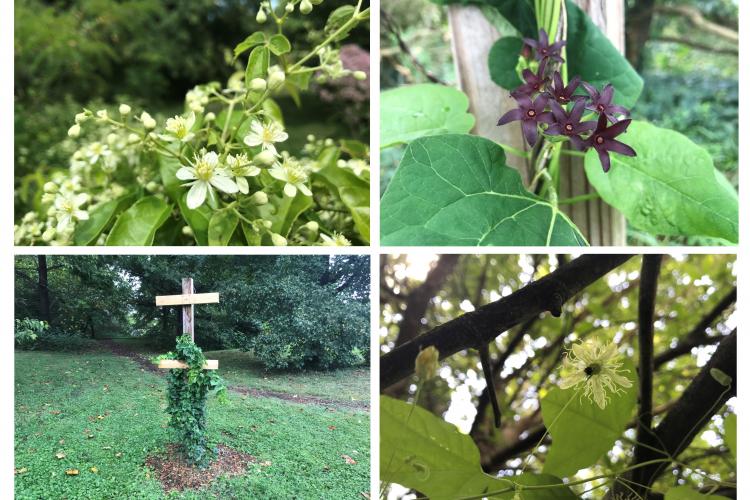Vines of the Walk Across Kentucky
Vines of the Walk Across Kentucky

An arboretum is a public garden that focuses on the display of woody plants, such as trees and shrubs. You may be surprised to hear that this also encompasses woody vines (lianas) which, along with perennial herbaceous vines, we grow in increasing numbers in the Walk Across Kentucky (WAKY). There is a total of 45 native accessioned vines in the WAKY, including naturally regenerating and wild-collected vines.
Non-native and invasive vines, like wintercreeper (Euonymus fortunei), porcelainberry (Ampelopsis brevipedunculata), Japanese honeysuckle (Lonicera japonica) and Asian bittersweet (Celastrus orbiculatus) spread and take over areas, replacing native species. However, native vines such as grapes (Vitis spp.), virginia-creeper (Parthenocissus quinquefolia), poison ivy (Toxicodendron radicans), and American groundnut (Apios americana) are naturally occurring in The Arboretum and grow quite prolifically without our help. These vines, perhaps with the exception of poison ivy, are welcomed and managed minimally.
In addition to these natural regenerators, we have purposefully collected and planted a growing and varied collection of woody and herbaceous native vines. These vines are generally planted near structures for climbing support and climb up and over bridges, vine posts, and occasionally trees.
Currently, late summer flowering vines are in bloom, including woodbine (Clematis virginiana, pictured), which is flowering along the Mississippi Embayment bridge, and yellow passionflower and maypop passionflower (Passiflora lutea var. glabrifolia, pictured; P. incarnata), which can be spotted in the Shawnee Hills. The perfoliate leaves and final red corollas of our native trumpet honeysuckle (Lonicera sempervirens, pictured) can still be found throughout the Mississippi Embayment, but the Kentucky-endangered Carolina milkvine (Matelea carolinensis, pictured) just finished flowering in the Pennyrile region. This August, our Dutchman’s pipe (Aristolochia macrophylla) was found to be the home of a population of pipevine swallowtail caterpillars (pictured), which feed exclusively on plants in the genus Aristolochia.
If you have been out to the Arboretum recently, you may have noticed new additions to our vine posts (pictured). These posts were placed about 3 years ago in order to more prominently display native vines, and until recently, they were simple posts with lengths of twine for climbing support. We found that we were having problems with the twine breaking and vines curling only around the twine, and not the post itself. To solve this problem, our 2018 summer interns researched methods in vine trellising and developed a system that would allow vines to climb up and over crossbeams, while providing more stability by using metal wire. These improved vine posts will likely need a bit more tweaking as the years go by, but have already helped show off our collection. Future improvements may include adding extra trellising materials, such as wire mesh.
With more wild-collecting trips, such as upcoming trips to the Daniel Boone National Forest, Berea Forest, Floracliff, and Bernheim Research Forest, we hope to collect seed from vines we would like to better represent in our collection, such as vasevine (Clematis viorna) and Dutchman’s pipe. We will continue to fill gaps in our collection and add new specimens in the coming years.

